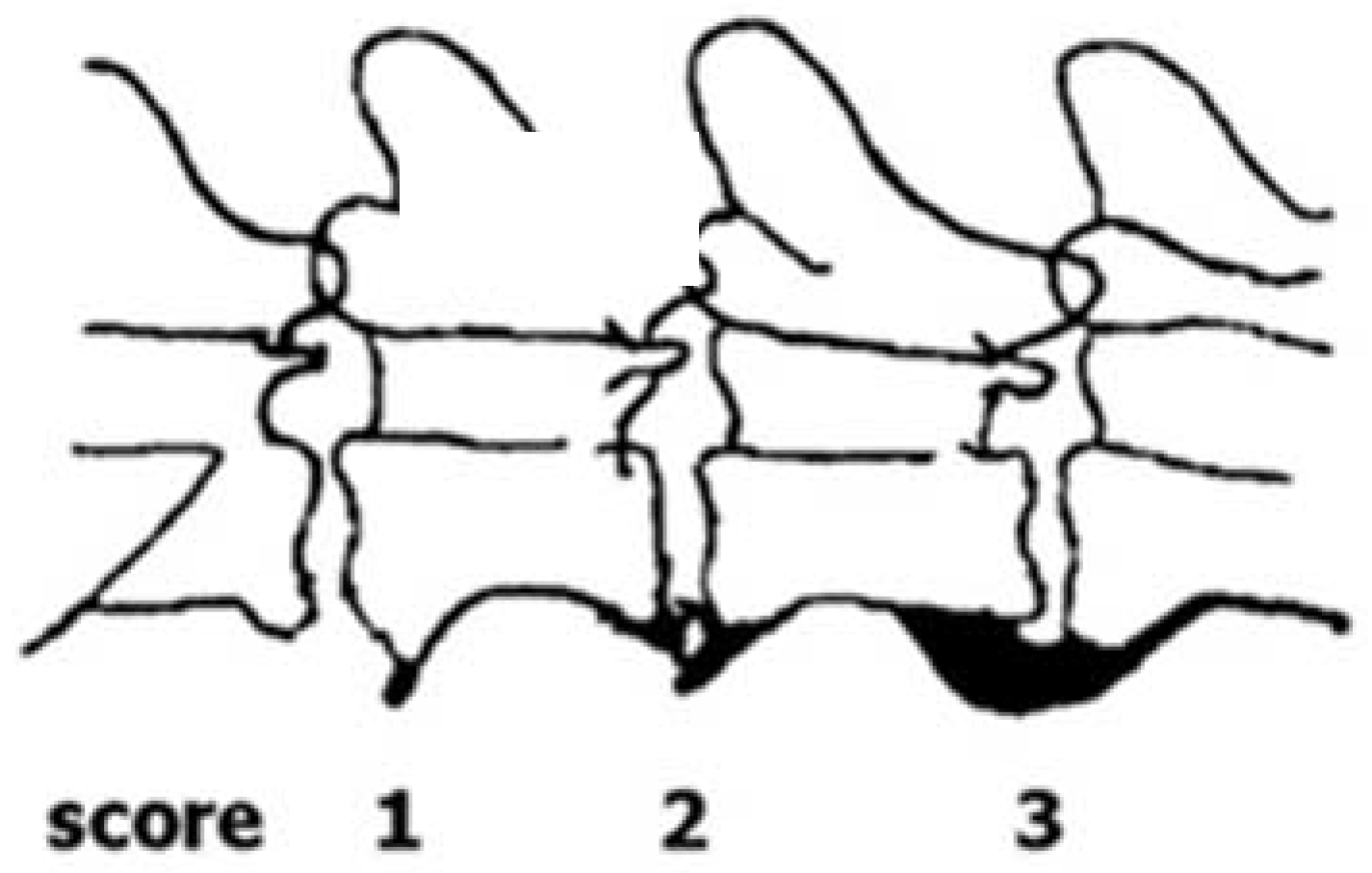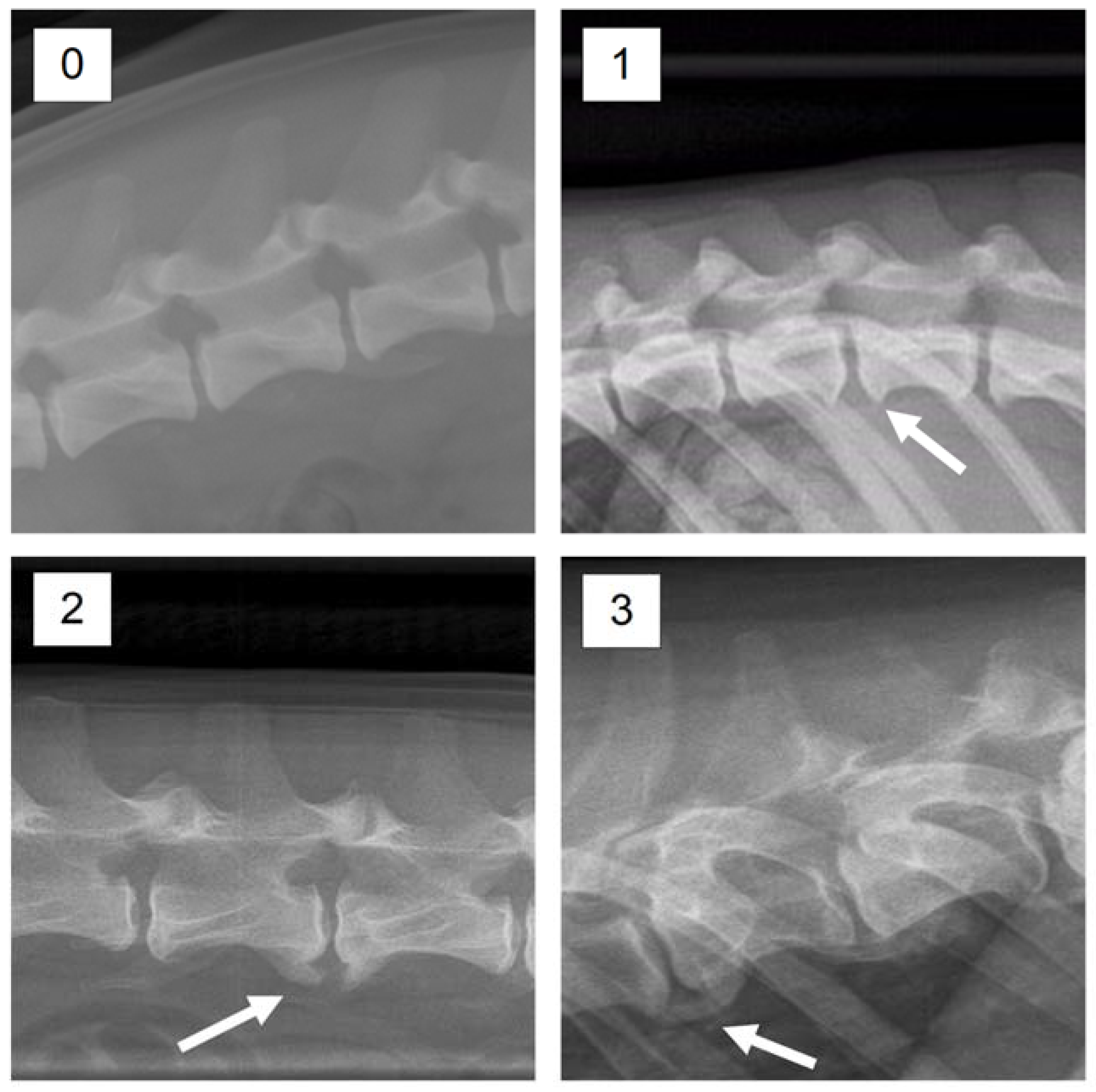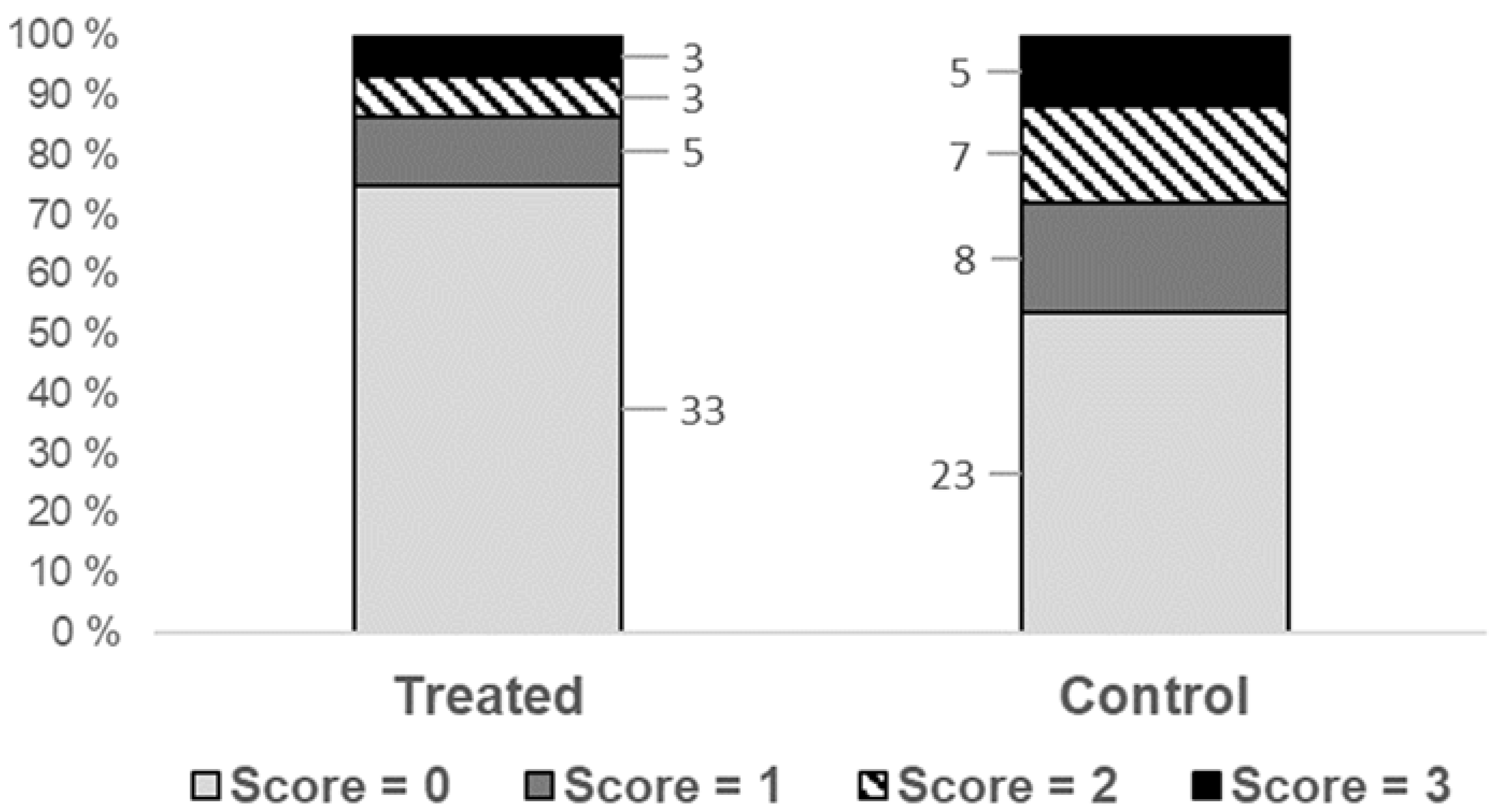Veterinary Chiropractic Treatment as a Measure to Prevent the Occurrence of Spondylosis in Boxers
Abstract
:1. Introduction
2. Materials and Methods
3. Results
4. Discussion
Supplementary Materials
Author Contributions
Funding
Institutional Review Board Statement
Informed Consent Statement
Data Availability Statement
Acknowledgments
Conflicts of Interest
References
- Hoskins, J.D.; Kerwin, S.C. Musculoskeletal system. Joint and vertebral column diseases. Vet. Clin. N. Am. Small Anim. Pract. 1997, 27, 1433–1449. [Google Scholar] [CrossRef]
- Moskowitz, R.W.; Ziv, I.; Denko, C.W.; Boja, B.; Jones, P.K.; Adler, J.H. Spondylosis in sand rats: A model of intervertebral disc degeneration and hyperostosis. J. Orthop. Res. 1990, 8, 401–411. [Google Scholar] [CrossRef] [PubMed]
- Kranenburg, H.C.; Meij, B.P.; van Hofwegen, E.M.L.; Voorhout, G.; Slingerland, L.I.; Picavet, P.; Hazewinkel, H.A.W. Prevalence of spondylosis deformans in the feline spine and correlation with owner-perceived behavioural changes. Vet. Comp. Orhop. Traumatol. 2012, 25, 217–223. [Google Scholar]
- Read, R.M.; Smith, R.N. A comparison of spondylosis deformans in the English and Swedish cat and in the English dog. J. Small Anim. Pract. 1968, 9, 159–166. [Google Scholar] [CrossRef] [PubMed]
- Meehan, L.; Dyson, S.; Murray, R. Radiographic and scintigraphic evaluation of spondylosis in the equine thoracolumbar spine: A retrospective study. Equine Vet. J. 2009, 41, 800–807. [Google Scholar] [CrossRef] [PubMed]
- Amabile, A.H.; Shea, R.J.; Desai, V.; Höglund, L.T.; Elcock, J.N.; Lombardo, A.; Schiffino, M.C. A Case of Thoracic Spondylosis Deformans and Multilevel Instrumented Spinal Fusion in an 84-Year-Old Male. Case Rep. Orthop. 2020, 8435816. [Google Scholar] [CrossRef] [PubMed]
- Kranenburg, H.C.; Voorhout, G.; Grinwis, G.C.M.; Hazewinkel, H.A.W.; Meij, B.P. Diffuse idiopathic skeletal hyperostosis (DISH) and spondylosis deformans in purebred dogs: A retrospective radiographic study. Vet. J. 2011, 190, e85–e90. [Google Scholar] [CrossRef]
- Morgan, J.P.; Ljunggren, G.; Read, R. Spondylosis deformans (vertebral osteophytosis) in the dog. A radiographic study from England, Sweden and U.S.A. J. Small Anim. Pract. 1967, 8, 57–66. [Google Scholar] [CrossRef] [PubMed]
- Morgan, J.P. Spondylosis Deformans in the Dog: A Morphologic Study with Some Clinical and Experimental Observations. Acta Orthop. Scand. 1967, 38 (Suppl. 96), 1–88. [Google Scholar] [CrossRef]
- Langeland, M.; Lingaas, F. Spondylosis deformans in the boxer: Estimates of heritability. J. Small Anim. Pract. 1995, 36, 166–169. [Google Scholar] [CrossRef]
- Thomas, W.B.; Fingeroth, J.M. Spondylosis deformans. In Advances in Intervertebral Disc Disease in Dogs and Cats; Fingeroth, J.M., Thomas, W.B., Eds.; Wiley: Hoboken, NJ, USA, 2014; pp. 67–74. [Google Scholar]
- Romatowski, J. Spondylosis deformans in the dog. Compend. Contin. Educ. Pract. Vet. 1986, 8, 531–535. [Google Scholar]
- Viateau, V.; Preault, H.; Moissonnier, P.; Breard, F.; Degorce-Rubiales, F.; Kenes, C. Characterization of biomechanical behavior of the lumbosacral spine in dogs. Characteristics related to spondylosis and disk degeneration. Chirurgie 1994, 120, 94–99, (In French with English summary). [Google Scholar]
- Levine, G.J.; Levine, J.M.; Walker, M.A.; Pool, R.R.; Fosgate, G.T. Evaluation of the association between spondylosis deformans and clinical signs of intervertebral disk disease in dogs: 172 cases (1999–2000). J. Am. Vet. Med. Assoc. 2006, 228, 96–100. [Google Scholar] [CrossRef] [PubMed]
- Carnier, P.; Gallo, L.; Sturaro, E.; Piccinini, P.; Bittante, G. Prevalence of spondylosis deformans and estimates of genetic parameters for the degree of osteophytes development in Italian Boxer dogs. J. Anim. Sci. 2004, 82, 85–92. [Google Scholar] [CrossRef] [PubMed] [Green Version]
- Breit, S.; Kunzel, W. Breed specific osteological features of the canine lumbosacral junction. Ann. Anat. 2001, 183, 151–157. [Google Scholar] [CrossRef]
- Langeland, M.; Stigen, O. Spondylosis deformans in the Boxer. Evaluation of the inclusion of oblique projections in radiographic studies. Norsk. Vet. 1995, 106, 297–303, (In Norwegian with English summary). [Google Scholar]
- Felleskatalogen. Available online: https://www.felleskatalogen.no/medisin-vet (accessed on 10 April 2021).
- Braund, K.G. Degenerative and Compressive Structural Disorders. In Braund’s Clinical Neurology in Small Animals: Localization, Diagnosis and Treatment; Vite, C., Ed.; International Veterinary Information Service: Arden Hills, MN, USA, 2003; Available online: https://www.ivis.org/library/braunds-clinical-neurology-small-animals-localization-diagnosis-and-treatment (accessed on 10 April 2021).
- Muir, W.W. Physiology and pathophysiology of pain. In Handbook of Veterinary Pain Management, 2nd ed.; Gaynor, J.S., Muir, W.W., Eds.; Elsevier: Amsterdam, The Netherlands, 2009; pp. 13–45. [Google Scholar]
- Muir, W.W.; Woolf, C.J. Mechanisms of pain and their therapeutic implications. J. Am. Vet. Med. Assoc. 2001, 219, 1346–1356. [Google Scholar] [CrossRef] [PubMed]
- Gaynor, J.S. The Physiology of Pain and Principles for its Treatment. In Mechanisms of Disease in Small Animal Surgery, 3rd ed.; Bojrab, M.J., Monnet, E., Eds.; Theton NewMedia: Jackson, WY, USA, 2017; Available online: https://www.ivis.org/library/mechanisms-of-disease-small-animal-surgery-3rd-ed/physiology-of-pain-and-principles-for-its-treatment (accessed on 10 April 2021).
- Hazewinkel, H.A.W.; Mott, J. Osteoarthrosis. In Encyclopedia of Canine Clinical Nutrition; Pibot, P., Biourge, V., Elliot, D.A., Eds.; Royal Canine: Aimargues, France, 2006; Available online: https://www.ivis.org/library/encyclopedia-of-canine-clinical-nutrition/osteoarthrosis (accessed on 10 April 2021).
- Aragon, C.L.; Hofmeister, E.H.; Budsberg, S.C. Systematic review of clinical trials of treatments for osteoarthritis in dogs. J. Am. Vet. Med. Assoc. 2007, 230, 514–521. [Google Scholar] [CrossRef] [PubMed]
- Gomez Alvares, C.B.; L’ami, J.J.; Moffat, D.; Back, W.; van Weeren, P.R. Effect of chiropractic manipulations on the kinematics of back and limbs in horses with clinically diagnosed back problems. Equine Vet. J. 2008, 40, 153–159. [Google Scholar] [CrossRef] [PubMed]
- Willoughby, S. Equine Chiropractic Care; Options for Animals Foundation: Wellsville, KS, USA, 1991; 156p. [Google Scholar]
- International Academy of Veterinary Chiropractic. Animal Chiropractic. Available online: https://i-a-v-c.com/en/academy/animal-chiropractic?fbclid=IwAR30MJORDbNdYG2Tsj0-8ei0QVfn_zDI4XiXbrZYnPPLikml_NJHiE7C-M0 (accessed on 25 July 2021).



| Litter No. | No. of Dogs in Total | Final Sample (X-rayed) | No. of Treatments | Parent Score (Male/Female) | ||
|---|---|---|---|---|---|---|
| Treated (Male/Female) | Control (Male/Female) | Treated (male/female) | Control (male/female) | |||
| 1 | 3 (1/2) | 3 (1/2) | 2 (0/2) | 2 (0/2) | 10 | 0/0 |
| 2 | 5 (2/3) | 4 (4/0) | 5 (2/3) | 4 (4/0) | 10–11 | 2/0 |
| 3 | 3 (3/0) | 4 (1/3) | 3 (3/0) | 4 (1/3) | 7–11 | 0/3 |
| 4 | 3 (1/2) | 4 (2/2) | 3 (1/2) | 4 (2/2) | 7–8 | 0/0 |
| 5 | 3 (1/2) | 3 (0/3) | 3 (1/2) | 3 (0/3) | 10 | 1/0 |
| 6 | 3 (2/1) | 1 (1/0) | 3 (2/1) | 1 (1/0) | 7–8 | 0/3 |
| 7 | 3 (2/1) | 4 (1/2) | 3 (2/1) | 3 (1/2) | 8 | 1/0 |
| 8 | 4 (3/1) | 3 (3/0) | 4 (3/1) | 2 (2/0) | 9–11 | 1/0 |
| 9 | 2 (1/1) | 2 (1/1) | 2 (1/1) | 2 (1/1) | 9–10 | 0/0 |
| 10 | 2 (1/1) | 4 (3/1) | 2 (1/1) | 4 (3/1) | 7–10 | 0/1 |
| 11 | 1 (0/1) | 2 (1/1) | 1 (0/1) | 1 (0/1) | 8 | 0/0 |
| 12 | 2 (1/1) | 3 (0/3) | 1 (0/1) | 2 (0/2) | 10 | 2/0 |
| 13 | 2 (1/1) | 2 (1/1) | 2 (1/1) | 2 (1/1) | 2–7 | 0/0 |
| 14 | 2 (0/2) | 5 (3/2) | 1 (0/1) | 1 (1/0) | 11 | 0/0 |
| 15 | 4 (1/3) | 2 (1/1) | 4 (1/3) | 2 (1/1) | 11 | 0/0,331) |
| 16 | 3 (1/2) | 3 (0/3) | 3 (1/2) | 2 (0/2) | 7–11 | 0/0 |
| 17 | 3 (0/3) | 6 (2/4) | 2 (0/2) | 4 (1/3) | 9–10 | 2/1 |
| Total | 48 (21/27) | 55 (25/30) | 44 (19/25) | 43 (19/24) | ||
| Parameter | Estimate | SE | DF | t-Value | p-Value |
|---|---|---|---|---|---|
| Intercept | 0.1485 | 1.1221 | 14 | 0.13 | 0.8966 |
| Chiropractic treatment = no | 1.0924 | 0.5420 | 69 | 2.02 | 0.0478 |
| Sex = male | −0.5858 | 0.5876 | 69 | −1.00 | 0.3233 |
| Parent with spondylosis = none | −2.1213 | 1.3266 | 69 | −1.60 | 0.1144 |
| Parent with spondylosis = one | −1.0122 | 1.2183 | 69 | −0.83 | 0.4089 |
| σ2 litter | 1.1798 | 0.9677 |
| Parameter | Estimate | SE | DF | t-Value | p-Value |
|---|---|---|---|---|---|
| Intercept | −1.8965 | 1.6102 | 14 | −1.18 | 0.2585 |
| Spinal joint mobility (1) | 0.5449 | 0.3621 | 26 | 1.50 | 0.1445 |
| Sex = male | −0.7042 | 0.8479 | 26 | −0.83 | 0.4138 |
| Parent with spondylosis = none | −1.3240 | 1.0951 | 26 | −1.21 | 0.2375 |
| Parent with spondylosis = one | −1.3780 | 1.0970 | 26 | −1.26 | 0.2202 |
| σ2 litter | 0 | − |
Publisher’s Note: MDPI stays neutral with regard to jurisdictional claims in published maps and institutional affiliations. |
© 2021 by the authors. Licensee MDPI, Basel, Switzerland. This article is an open access article distributed under the terms and conditions of the Creative Commons Attribution (CC BY) license (https://creativecommons.org/licenses/by/4.0/).
Share and Cite
Halle, K.S.; Granhus, A. Veterinary Chiropractic Treatment as a Measure to Prevent the Occurrence of Spondylosis in Boxers. Vet. Sci. 2021, 8, 199. https://doi.org/10.3390/vetsci8090199
Halle KS, Granhus A. Veterinary Chiropractic Treatment as a Measure to Prevent the Occurrence of Spondylosis in Boxers. Veterinary Sciences. 2021; 8(9):199. https://doi.org/10.3390/vetsci8090199
Chicago/Turabian StyleHalle, Kristin Steinmoen, and Aksel Granhus. 2021. "Veterinary Chiropractic Treatment as a Measure to Prevent the Occurrence of Spondylosis in Boxers" Veterinary Sciences 8, no. 9: 199. https://doi.org/10.3390/vetsci8090199
APA StyleHalle, K. S., & Granhus, A. (2021). Veterinary Chiropractic Treatment as a Measure to Prevent the Occurrence of Spondylosis in Boxers. Veterinary Sciences, 8(9), 199. https://doi.org/10.3390/vetsci8090199






